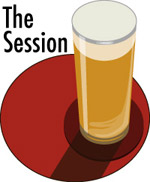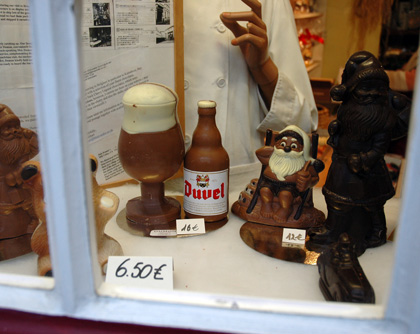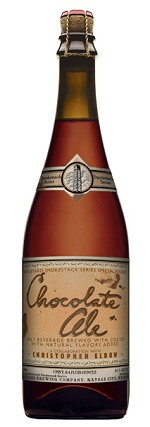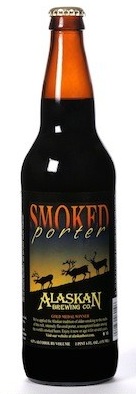 For The Session #65 Nate Southwood asked that we write about going to the pub, or bar, alone.
For The Session #65 Nate Southwood asked that we write about going to the pub, or bar, alone.
From the first pages of The Beer Travelers Guide (1995 – the 7,383,107th best seller on Amazon, last time I looked):
Broad Ripple Brewpub owner John Hill (in Indianapolis) likes to tell a story about when he was growing up in Yorkshire, England, and would visit pubs with his father. While it may have appeared to an outside that neighborhood pubs were serving the same beer, the locals knew better. “One cellarman might be adding a little brown sugar, another kept his beer a little fresher . . .,” Hill recalled.
So John’s father had his favorite pubs, but if one of them was nearly empty while the place across the street was busy, he would head to the less-favored one. Why? Because, as Hill says, “An Englishman doesn’t drink alone.”
The world’s best drinking companion and I wrote that to explain what we were looking for when we compiled the guide. But also to make a point about how Beer Different (sort of like Santa Fe likes to be known as “The City Different”) had changed things for the better. When you walked into a brewpub, or a bar serving Beer Different you could usually expect you wouldn’t have to drink alone. That there’d be a conversation waiting because there was a good chance you shared something in common with the other customers. Yes, beer, but usually something else.
This may be a Pollyannaish view. And it might have worked just as well in an Old Style bar. I never bothered to find out. That was probably a mistake, because I like eavesdropping in bars almost as much as I like talking. I once stopped in this spot (the Sandia Bar), which was about a mile from our house in New Mexico, and asked what beers they had. Sometimes a place will at least have a bottle of Samuel Adams stuck in the cooler (although it might be two years old; true story). Not here.
Too bad, because later they shot a bit of “Breaking Bad” in the bar. Dean Morris, who plays Hank, rented a house in Corrales while the series was being shot and apparently stopped in from time to time. Now that would have been some good eavesdropping.
So, tangent over, back to The Session and talking beer because, philosophizing aside, that is what The Session is supposed to be about. Monday I had a few of them in a few places with the famous Thirsty Pilgrim (Joe Stange), starting appropriately enough with an Urban Chestnut beer served in a stange (and I shouldn’t have to tell you what German city it reminded us of). I finished with tart wheat beer from 4 Hands Brewing (again, you should be able to figure out the German city).
Rumor has it that it will be 105° today in St. Louis, as it has been pretty much every day for more than a week. Thank goodness there are beers like these, brewed for Summer in the City.

 Having once accidentally driven a car into a large pedestrian-only square in Brugge I can assure you this is a city best enjoyed on foot. You can just stop and stare at the architecture. That the streets are narrow and winding becomes charming instead of exasperating. And there are the chocolate shops.
Having once accidentally driven a car into a large pedestrian-only square in Brugge I can assure you this is a city best enjoyed on foot. You can just stop and stare at the architecture. That the streets are narrow and winding becomes charming instead of exasperating. And there are the chocolate shops. Alaskan Brewing co-founder Geoff Larson tells a good story. One you want to listen sitting next to a roaring fire on a Juneau beach.
Alaskan Brewing co-founder Geoff Larson tells a good story. One you want to listen sitting next to a roaring fire on a Juneau beach.